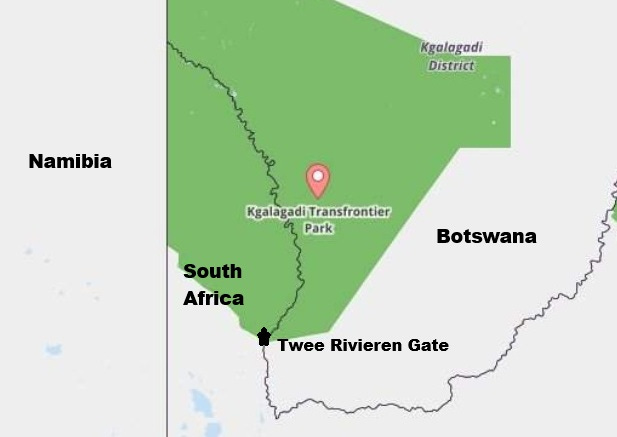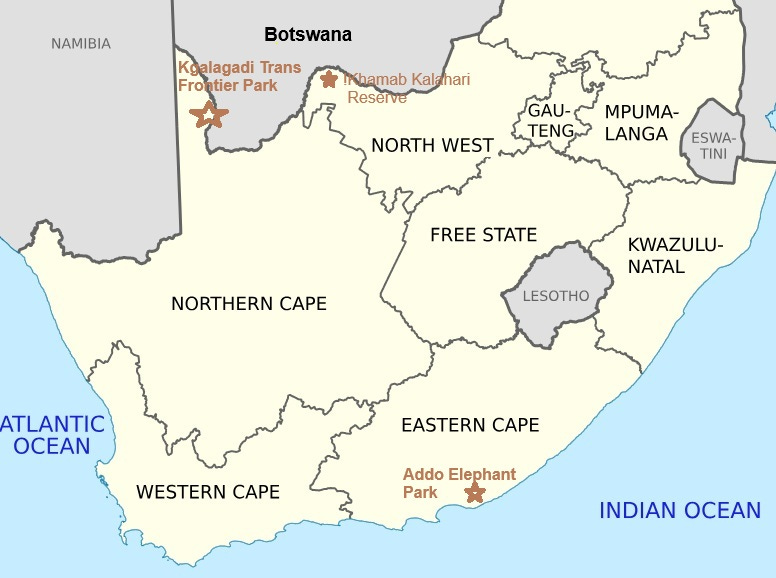
The story below is based on information sourced from an array of social media posts. I am reasonably certain that this account is accurate because I cross-referenced extensively, but I cannot be 100% sure of every detail. I contacted official sources at SANParks, Addo Elephant Park management and the Honorary Rangers – they all refused to say anything beyond, “Wait for the press release”.
Kij Kij Brothers acquire a taste for livestock
Earlier this year, two adult male lions known by visitors to the Kgalagadi Transfrontier Park as the Kij Kij Brothers left that park and killed livestock on neighbouring farms. Subsequently they returned to the safety of the park but then over the coming weeks they made several new forays beyond its boundaries. The two Kalahari lions reportedly killed six cows, a donkey and a horse in Botswana (see map below). They also took several sheep beyond the Twee Rivieren Gate inside South Africa.
The Kij Kij males are beautiful lions with thick gorgeous manes framing their imperious faces. I have seen many photos of them on social media and can confirm that they are indeed perfect examples of what majestic lions are supposed to look like.
The prospects for the Brothers did however, not look good. As the fences around the Kgalagadi Park appear to be permeable, and the two lions have discovered how easy it is to hunt farm animals, management had to take a decision about what to do with them. Farmers would happily shoot the raiders to protect their livestock, but this would mean a terrible loss of two big cats in their prime.
Another suggestion was to dart the lions and move them to the northern part of the 38 000 km² Park. The reasons for discarding this option were not revealed to the public.

Park rangers working with vets darted the lions and moved them to a boma (an enclosure) near Twee Rivieren in March this year. Rumours began flying around the ether that the two were going to be moved to the Addo Elephant Park.
Kgalagadi regulars mourn their loss
Frequent visitors to Kgalagadi were dismayed. They had become accustomed to spending many hours observing and photographing the Kij Kij Males. Online messages lamented the loss of these two impressive beasts and the outpouring of grief was astonishing. People wrote long tributes to the Brothers that could compare to elegies for lost (human) relatives.

Facebook user, Safari Nest, wrote about the Kij Kij Brothers that “fate has taken a cruel turn. The very instincts that have made them formidable—their ability to hunt, to provide, to survive—have now become their downfall”.
He added, “The Kij Kij males will move on, as lions always do, but the land they leave behind will feel emptier without them. And for those who have watched them, admired them, and felt the raw power of their presence, the loss is deeply felt. They were never just lions; they were legends of the land, and now, their story takes an uncertain path.”
A different user responded on Facebook, “Breaks my heart! We are their custodians and yet we fail dismally as humans. Conservation fees need to build strong fences so that they are safe! Sobbing as I read so well written Mo!”
I understand this unhappiness. It is no different from how Addo Addicts felt when the lion known as Jack was moved from the Addo Elephant Park to Shamwari Private Game Reserve. It was a devastating blow and many felt somehow betrayed.
Kgalagadi visitors feel many emotions from anger to duplicity to sympathy. They understand why some action needed to be taken, but they thought it wasn’t fair on the Brothers and on their pride who would now be without guardians. They feel deprived of one of their most prized celebrities.
It is precisely for this reason that SANParks management is not keen on giving anthropomorphic names to wild animals. Visitors build emotional attachments to them and when the animals are removed, or die, as they inevitably do, regulars become upset and blame the managers.
In the case of the Kij Kij brothers some posts circuitously blamed management for taking action against animals that were only doing what comes naturally – hunting for their dinner.
After spending some time in a boma in the Kgalagadi Park, the two were translocated to a boma in Addo. At the time of writing this newsletter, the Kij Kij Brothers remain in that boma.
When will they be released? I have been repeatedly told to “wait for the press release”.
The imminent release of two Kalahari lions into the main section of the Addo Park could be problematic. Let me provide some context.
Some background on the Addo lions
The three lionesses (Josie, Dawn and Duffy) and the two males (Niklaas and Witwarm) in the main section of Addo are reaching their sunset years. The two males, at about 14 years-old, have enjoyed a charmed life beyond the usual 10-12 year lifespan in the wild. The Park needed an infusion of younger genes.
The !Khamab Kalahari Reserve in the North West Province of South Africa answered this need when they donated two young (two-and-a-half year old) lionesses to Addo toward the end of last year. The distance separating the two parks, however presented a serious obstacle.
The distance from Khamab to Addo is more than 1,000 kms., which means that a road trip could be tricky. The rangers would probably have to keep the lions sedated for longer than 12 hours.
A few days before Christmas 2024, The Bateleurs, an organisation that identifies itself as Volunteers flying for the environment, used a single-engined Cessna 210 to translocate the two lionesses to Addo. There was barely enough space for them in the aircraft during the three-and-a-half hour flight.
Nevertheless, the journey was completed and the two lionesses, informally known as Khama and Kala, were acclimatized to their new environment in a boma near Rooidam until March 3, 2025.
They were released in the north of the main section quite far from where the resident five lions usually go about their business.

Josie and her girls did not seem to wander far from their usual haunts near Arizona Dam, but the two males did not take long to find Khama and Kala in the Domkrag area. Fourteen-years-old or not, they did not waste time before Niklaas and Witwarm were mating with the new arrivals.
Their procreation sessions went on for several days – the boys were just making sure. Now, for the first time since April 2017, we can expect the arrival of new lion cubs sometime around the middle of September.
This will be a momentous occasion that most Addo Addicts will enthusiastically welcome.
Except that . . . the Kij Kij Brothers
We don’t know when park management will release the Kij Kij Brothers, and under what circumstances.
If the Brothers are simply let go in the main section it is almost certain that they will end up in a life-or-death battle with the resident males, Niklaas and Witwarm.
At eight-years-old the Kij Kij Brothers are in their prime and will certainly be more than a match for the 14-year-olds. They will probably kill the old boys who have been having the time of their lives with the nubile Khama and Kala.
The Brothers will be instantly attracted to the young lionesses and will not be happy to find they are pregnant. When Khama and Kala give birth to the progeny of the old males they will instinctively want to devote their time and energy to caring for the cubs. The Kij Kij Brothers will not tolerate that possibility. They will want to mate with the lionesses as soon as possible and the best way of bringing them into oestrus will be to kill the cubs.
This tragic prospect is the most likely outcome of the introduction of the two Brothers. That is unless Addo Park Management has another plan up their collective sleeves.
The Addo Elephant Park belongs to SANParks – a public institution – yet they refuse to discuss their plans with members of the public.




